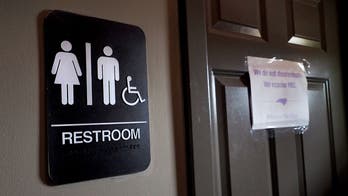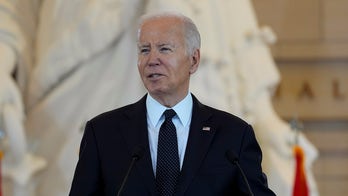A weekend has passed with seemingly no movement between Congress and President Obama toward crafting an agreement to boost the federal debt ceiling.
If they fail, look no further than those Freescore.com commercials that run on cable television to grasp America's new status on the global stage.
The United States has enjoyed an unparalleled status for decades when it comes to credit worthiness.
Compared to everyone else, the U.S. was one of those chiseled, consensus All-America quarterback types that appear in the Freescore.com ads. The commercials feature a couple of these strapping gents decked out in unitards, standing Superman-style with their hands on their hips. The credit scores of "790" and "775" emblazoned across the chests of their skintight togs.
If the U.S. defaults, expect global markets to view the nation much differently.
Bumbling along in those Freescore ads is a balding little man in a lumpy bodysuit. He covers his face with a 1973-era hockey mask. The credit score "583" is stamped across his get up.
The U.S. usually looks like the Winklevoss twins from "The Social Network" But unless something happens soon, the nation could soon resemble George Costanza with accessories from Ken Dryden.
It's not that leaders in Washington haven't tried to find common ground. They have. But House Majority Leader Eric Cantor (R-VA) summed up the state of affairs best last week.
"Nothing can get through the House right now," lamented Cantor.
The same can be said for the U.S. Senate.
At this stage, it doesn't matter what President Obama proposes. It doesn't matter what House Speaker John Boehner (R-OH) wants. It doesn't matter what the tea party envisions as a recipe for deficit reduction.
A majority of lawmakers in both the House and Senate must be willing to vote for some plan aimed at averting a federal default. And as Cantor says, that's not in the cards right now.
Who caused this pickle?
Voters.
It's often said that elections have consequences. And the lack of capacity by both Republicans and Democrats to come to a debt limit agreement is a direct consequence of what's happened at the polls in 2006, 2008 and 2010.
Rarely has the American political pendulum oscillated as erratically as it has in the past three elections. 2006 and 2008 were pivotal votes as Americans stripped Republicans of their House and Senate majorities. In the House, Democrats nearly maxed out the map of seats their party could conceivably hold. Americans rewarded Mr. Obama with 365 electoral votes, a figure eclipsed in only 16 previous presidential elections.
The political world practically spun off the Obama-Democrats axis two years later.
Driven by a populist opposition to the health care law and punctuated by the tea party movement, Republicans reclaimed all of those Democratic gains and then some. The GOP came close to winning the Senate too, nearly wiping out Senate Majority Leader Harry Reid (D-NV).
A new progeny of lawmaker arrived in Washington, embodied in the form of tea party favorites like Sens. Rand Paul (R-KY), Mike Lee (R-UT) and Marco Rubio (R-FL), ballasted by 87 influential GOP House freshmen.
This sort of swing explains why it's nearly impossible to brew just the right bill to pass Congress.
The tea party freshmen represent a stark contrast to the electorate that supported President Obama in 2008. Most tea party faithful don't want to raise the debt ceiling at all. And at the very least, they want a bill with profound cuts.
This is where the demands of the 2010 midterm electorate clash with the vales of the 2008 electorate. Representing his robust electoral victory in 2008, there's no way that Mr. Obama will sign a bill that gets anywhere close to the hopes of the tea party.
Meantime, the likes of Boehner, Cantor, Reid, House Minority Leader Nancy Pelosi (D-CA) and Senate Minority Leader Mitch McConnell (R-KY) are in the middle of this vortex trying to find common ground. All of them want to avoid a debt crisis.
Republicans have enjoyed pushing the president to the right in search of a solution. But the trouble for the GOP leadership is that a substantial number of Republicans simply won't support a debt ceiling increase at all, with or without momentous cuts.
That means Republicans need help from Democrats. And those Democrats won't accept the types of cuts that the GOP or even the president is calling for.
The careening trajectory of the electorate over the past three cycles has triggered this debacle. And no one has a flashlight powerful enough to illuminate a path out of this legislative labyrinth.
The Founders wanted to make it hard for the legislative and executive branches to reach accord and pass law. That gave rise to a system of staggered elections for the House, Senate and presidency. It diluted power into three distinct epicenters and jammed up the works. The Founders only wanted to open the gateways to a new law when it was clear legislators and the executive could successfully navigate all hurdles, thus reflecting the political temperatures of various electoral years (say, 2006, 2008 or 2010).
It's a tall order. And it brings us to the unique standoff between the sides today.
In lieu of a bona fide fix, the House will at least show what it's capable of this week, mostly representing the electoral flavor of 2010. It comes in the form of something called "Cut, Cap and Balance" (CCB). The Republican Study Committee (RSC), the bloc of nearly 180 of the most-conservative Republicans in the House, construed CCB. CCB provides for hiking the debt limit by $2.4 trillion. But only on the condition that both chambers of Congress approve a Constitutional balanced budget amendment first.
In a statement, RSC chairman Rep. Jim Jordan (R-OH) described CCB as "the only solution that can pass Congress and actually stop the out-of-control growth of our debt." Jordan could be right about the latter part. However, this plan has virtually no support from Democrats. And it will be near-impossible to get both the House and Senate to approve a balanced budget amendment.
In addition, some conservatives won't vote at all for CCB because it includes a contingent debt limit increase.
CCB pours concrete caps on federal spending, limiting it to a percentage of GDP. It cleaves $111 billion in spending in its first year.
So why would John Boehner allow such a program that has no chance in the Senate to hit the House floor?
It's called exhausting options.
Boehner knows CCB doesn't have a chance with the Senate and certainly not with President Obama. In fact, the cuts are so stark, there's a chance it might not even pass the House. But for Boehner, this is an effort to let the House work its will, even if it's unlikely this could be a part of any final arrangement.
First, Boehner's decision to drop such a proposal on the floor inoculates him from criticism that he didn't give conservatives what they want. In this instance, the best-case scenario for Boehner could be for CCB to fail. That demonstrates to Boehner's right flank that the House needs to work toward a middle ground solution.
At the very least, if CCB passes, it tees up a potential vote (or votes) on the holy grail for fiscal conservatives: a Constitutional balanced budget amendment. CCB mandates that a balanced budget amendment curb expenditures from exceeding receipts, impose a supermajority to raise taxes and restrict spending as a percentage of GDP.
Constitutional amendments require a two-thirds vote by both chambers of Congress plus passage by three-fourths of the states. Considering the makeup of the House with vacant seats and the absence of Rep. Gabrielle Giffords (D-AZ), such an amendment would need 288 votes to pass. Factor in a few more AWOL lawmakers that day and the two-thirds figure is somewhere in the mid-280s.
There are currently 240 Republicans in the House. If all of them are present and vote yes, they still need well over 40 Democrats to achieve the two-thirds threshold. That's a lot fewer than the 72 Democrats who joined with Republicans to approve a balanced budget amendment in 1995. But it's unlikely the House can get within striking distance on a balanced budget amendment in this climate.
"This is even worse than I had heard," said Nancy Pelosi last week when asked about the CCB and balanced budget amendment. In other words, if the Democratic leader is so adamantly opposed, don't expect much help from the rank-and-file.
Regardless, a balanced budget amendment vote could be more about the 2012 elections and less about solving the debt ceiling issue. Such a vote helps Republicans to tee up commercials against Democrats unwilling to vote to amend the Constitution as the GOP could blame the other side for its failure.
After days of brinksmanship in April, Boehner, Reid and the president finally engineered a compromise to avoid a government shutdown and cut $61 billion in spending this fiscal year.
"This is the best deal we could get out of them," Boehner told House Republicans at a closed door meeting announcing the pact.
But 59 House Republicans voted against Boehner on that package. Even more groused about what they perceived as the paucity of the cuts.
In this instance, Boehner might not be able to secure a deal at all with the president. And certainly not one that he can support or will be backed by House Republicans.
"I was not elected to kick the can down the road," said freshman Rep. Bill Flores (R-TX) late last week. "We were brought here to do something."
So the House will in fact "do something" this week with Cut, Cap and Balance and potentially a balanced budget amendment. But it won't necessarily drive the sides closer to an agreement. Votes on CCB and a balanced budget amendment represent the results of the 2010 midterms. And a failure to cave a debt limit deal denote the yawning chasm between the messages the electorate sent in 2006, 2008 and 2010 as they're translated into the votes of lawmakers on the House and Senate floors.
Elections have consequences. And because they do, that could explain why no one's found a legislative path to avoid a federal default on August 2.




